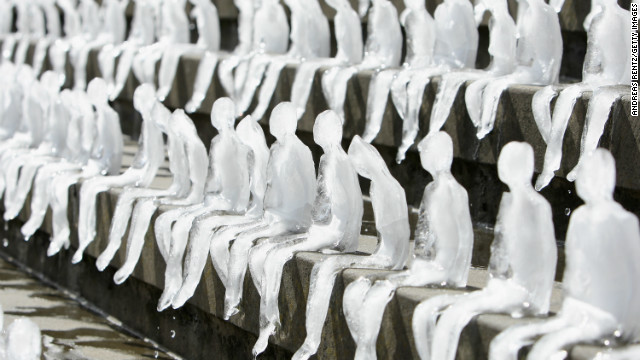Last year's elections saw the country's leaders tackle many of our most pressing issues. However, climate change did not seem to be one of them. This year, the discussion seem to be making a comeback, after the nation saw firsthand how extreme weather events have cost our economy billions of dollars in recovery. This CNN article details how climate change may be a hot topic in the World Economic Forum in Davos this month.
 |
| Image source: CNN |
(CNN) -- As leaders gather for the World Economic
Forum in Davos, signs of economic hope are upon us. The global economy
is on the mend. Worldwide, the middle class is expanding by an estimated
100 million per year. And the quality of life for millions in Asia and
Africa is growing at an unprecedented pace.
Threats abound, of
course. One neglected risk -- climate change -- appears to at last be
rising to the top of agendas in business and political circles. When the
World Economic Forum recently asked 1,000 leaders from industry,
government, academia, and civil society to rank risks over the coming
decade for the Global Risks 2013 report, climate change was in the top three. And in his second inaugural address, President Obama identified climate change as a major priority for his Administration.
For good reason: last year was the
hottest year on record for the continental United States, and records for
extreme weather events
were broken around the world. We are seeing more droughts, wildfires,
and rising seas. The current U.S. drought will wipe out approximately
1%
of the U.S. GDP and is on course to be the costliest natural disaster
in U.S. history. Damage from Hurricane Sandy will cost another 0.5% of
GDP. And
a recent study found that the cost of climate change is about $1.2 trillion per year globally, or 1.6% of global GDP.
Shifting to low-carbon
energy sources is critical to mitigating climate change's impacts.
Today's global energy mix is changing rapidly, but is it heading in the
right direction?
Coal is the greatest
driver of carbon dioxide emissions from energy, accounting for more than
40% of the total worldwide. Although coal demand is falling in the
United States -- with 55 coal-powered plants closed in the past year --
it's growing globally. The World Resources Institute (WRI) recently
identified
1,200
proposed new coal plants around the world. And last year, the United
States hit a record-high level of coal exports—arguably transferring
U.S. emissions abroad.
Meanwhile, shale gas is
booming. Production in the United States has increased nearly tenfold
since 2005, and China, India, Argentina, and many others have huge
potential reserves. This development can be an economic blessing in many
regions, and, because carbon emissions of shale gas are roughly half
those of coal, it can help us get onto a lower carbon growth path.
However, while gas is an
important bridge to a low carbon future—and can be a component of such a
future—it can't get us fully to where we need to be. Greenhouse gas
emissions in industrial countries need to fall by 80-90% by 2050 to
prevent climate change's most disastrous impacts. And there is evidence
that gas is crowding out renewables.
Renewable energy --
especially solar and wind power -- are clear winners when it comes to
reducing emissions. Unfortunately, despite falling prices, the financial
markets remain largely risk-averse. Many investors are less willing to
finance renewable power. As a result of this mindset, along with policy
uncertainty and the proliferation of low-cost gas, renewable energy
investment dropped 11%, to $268 billion, last year.
What do we need to get on track?
Incentivizing renewable energy investment
Currently, more than 100
countries have renewable energy targets, more than 40 developing
nations have introduced feed-in tariffs, and countries from
Saudi Arabia to
South Africa
are making big bets on renewables as a growth market. Many countries
are also exploring carbon-trading markets, including the EU, South
Korea, and Australia. This year, China launched pilot trading projects
in five cities and two provinces, with a goal of a national program by
2015.
Removing market barriers
Despite growing demand
for renewable energy from many companies, this demand often remains
unmet due to numerous regulatory, financial, and psychological barriers
in the marketplace.
In an effort to address these,
WRI just launched the Green
Power Market Development Group in India, bringing together industry,
government, and NGOs to build critical support for renewable energy
markets. A dozen major companies from a variety of sectors—like
Infosys, ACC, Cognizant,
IBM,
WIPRO,
and others— have joined the initiative. This type of
government-industry-utility partnership, built upon highly successful
models elsewhere, can spur expanded clean energy development. It will be
highlighted in Davos this week at meetings of the Green Growth Action
Alliance (G2A2).
De-risking investments
For technical, policy,
and financial reasons, risks are often higher for renewables than
fossil-based energy. Addressing these risks is the big remaining task to
bring about the needed energy transformation. Some new funding
mechanisms are emerging that can help reduce risk and thus leverage
large sums of financing. For example, the
Green Climate Fund
could, if well-designed, be an important venue to raise funds and drive
additional investments from capital markets. Likewise, multi-lateral
development banks'
recent $175 billion commitment to sustainable transport could help leverage more funds from the private and public sectors.
Some forward-looking
companies are seeking to create internal incentives for green
investments. For example, companies like Unilever, Johnson &
Johnson, and UPS have been taking actions to reduce internal hurdle
rates and shift strategic thinking to the longer-term horizons that many
green strategies need.
Davos is exactly the
type of venue for finding solutions to such issues, which requires
leadership and coalition-building from the private and public sectors.
For example, the the G2A2, an alliance of CEOs committed to addressing
climate and environmental risks, will launch the Green Investment Report
with precisely the goal of "unlocking finance for green growth".
Depending on what happens at Davos—and other forums and meetings like it throughout the year—2013 could just be a game-changer.
Weather is increasingly unpredictable. Keep your home temperature stable with cost-effective heating and cooling systems. Get a free quote from
. See more information on this
.




